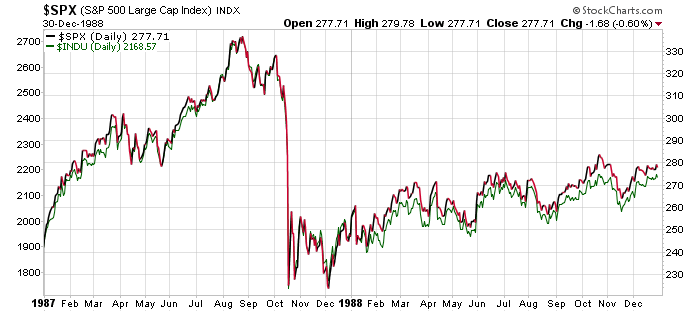Protect your portfolio from another Black Monday
Post on: 15 Апрель, 2015 No Comment

MarkHulbert
Getty Images
As we mark the 26th anniversary of the 1987 stock-market crash, the worst in U.S. history, it is worth asking whether such an event could happen again.
According to a number of researchers, the answer is yes. And that is a sobering thought indeed, since the Dow Jones Industrial Average DJIA, +1.47% fell 22.6% on Oct. 19, 1987. An equivalent drop today would take more than 3,400 points off the Dow in a single session.
The stock market recovered from the Black Monday crash within two years. But Xavier Gabaix, a finance professor at New York University, says that recoveries aren’t always this rapid. In fact, the market on average following past crashes didn’t completely recover after even 10 years.
To prevent a crash from completely derailing your investment strategy, you might need to reduce the portion of your portfolio invested in stocks — especially if you have less than a decade in which to recoup your losses or lack the nerves of steel required not to bail out of stocks after a crash.
Discuss key earnings announcements before and after results come in. Learn more
Gabaix and fellow researchers have developed a theory that predicts, over long periods, how many daily price drops of various magnitudes will occur over long periods. For example, their theory forecasts that a 20% daily drop in the market will occur, on average, once every 100 years, a 15% plunge once every 50 years and a 10% drop once every 13 years. Gabaix said that the theory has been found to be quite accurate when tested against U.S. stock-market history back to the early part of the last century, as well as against the stock markets of Japan and Hong Kong.
That means regulators are tilting at windmills in trying to prevent another crash. Structural changes such as circuit breakers and trading halts ultimately will fail, Gabaix argues, since large investors always can go elsewhere to sell. For example, they can turn to private electronic-transaction networks in the U.S. known as “dark pools,” as well as to foreign markets.
T. Rowe Price fund finds value Ii Europe, Japan
International small-cap stocks are fairly valued, says Jason White, portfolio specialist on T. Rowe Price International Discovery Funds investment team. Southern Europe and Japan offer value.
Because crashes are both inevitable and unpredictable, you need to permanently insulate your portfolio against them, unless you have a very long investment horizon and the discipline to stick with your strategies even in the wake of a crash.
Unfortunately, cushions are rare during crashes. The average foreign stock lost just as much in October 1987 as did the U.S. market, for example; stocks of gold-mining companies did even worse. Gold bullion itself held its own during the 1987 crash, but its behavior during prior crashes was inconsistent.
One study, by Duke University finance professor Campbell Harvey and Claude Erb, a former commodities manager at TCW Group, found that in over a third of the cases in which the S&P 500 SPX, +1.26% experienced a big drop, so did gold.
Though U.S. Treasurys did hold their own during the 1987 crash, it is difficult to imagine — given today’s low interest-rates — that bonds will provide much insurance against a crash. And if interest rates rise, as they almost certainly will over the long term, bonds could prove to be expensive insurance indeed.

That leaves cash-like instruments, such as money-market funds, and short-term bonds as the primary options for conservative investors wanting to protect themselves against a crash.
The question is: How much should be allocated to these risk-reducing investments by investors nearing retirement, as well as by risk-averse investors of any age?
The Hulbert Financial Digest produced a list of advisers who lost less than half as much as the Dow during the 1987 crash and who, since then, have beaten the Dow. We then eliminated those whose good performance was due to building up cash right before the 1987 crash, since crashes are unpredictable and you can’t count on sidestepping them in the future.
With the exception of one adviser who is always fully invested in stocks, the half-dozen advisers in this subset, out of the more than 200 in the Hulbert database, have allocated an average of close to 40% to cash and short-term bonds over the past 26 years.
That might seem like overkill, especially if you are young. But note that these conservative advisers have kept up with the market since 1987. Even if such an allocation causes you to trail the market, it could be a small price to pay for a strategy you can live with through thick and thin.
One place where some of these advisers invest their cash is the Vanguard Prime Money Market Fund VMMXX, +0.00% , which holds cash-like investments and has an expense ratio of 0.16%, or $16 per $10,000 invested. The short-term bond fund that is most recommended by these advisers is the Vanguard Short-Term Investment Grade Fund VFSTX, +0.09% , with a 0.2% expense ratio.
The one advisory service in my select group that has remained fully invested in stocks is Investment Quality Trends, edited by Kelley Wright. Its portfolio, consisting entirely of high-dividend-yielding blue chips, lost less than half the market in the 1987 crash. And over the 26 years since that crash, it has outperformed the Dow.
The three highest-yielding stocks on Wright’s best-buy list are Baxter International BAX, -0.01% , the drug and medical-device maker, whose dividend yield — annual dividend payout as a percentage of its current stock price — is 3%; oil giant Chevron CVX, -1.08% , yielding 3.3%; and fast-food retailer McDonald’s MCD, +1.36% , yielding 3.3%.














